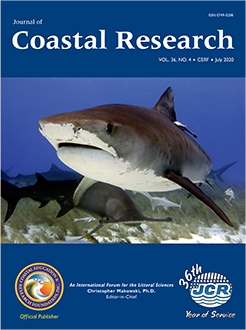Black, K.P.; Reddy, K.S.K.; Kulkarni, K.B.; Naik, G.B.; Shreekantha, P., and Mathew, J., 2020. Salient evolution and coastal protection effectiveness of two large artificial reefs. Journal of Coastal Research, 36(4), 709–719. Coconut Creek (Florida), ISSN 0749-0208.
Two offshore reefs constructed at Ullal, Karnataka, on India's west coast, are exhibiting coastal protection benefits. The reefs are large (275 m and 325 m long) and uniquely placed well offshore (600 m and 760 m) in intermediate depths (6 and 7 m below chart datum). Their crests are between low-tide and midtide level. Bathymetric and beach surveys show that sand has accumulated to form two evolving shoreline salients, which are currently 2–3 times the length of the reefs. The salients have grown underwater on the inner shelf to create a large sand-retention zone up to 1 m thick and stretching from the beach to the distant lee of the reefs. The reefs are the first protection structures that have restored the beaches and enhanced sand storage over this broad, severely eroded region, both inshore and on the inner shelf. Prior rubble-mound rock revetments (seawalls) and 50–70-m-long groynes failed to restore the beach in stormy monsoon conditions, while the inner shelf continued to erode. The reefs were designed using a combination of computer simulations, measurements of natural salients in India, and empirical relationships. The methodology that led to the reef shapes/sizes and their position offshore is discussed, along with monitoring results.





